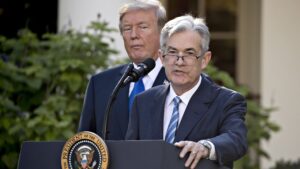The Tension Between Monetary Policy and Political Ambitions: Eyes on Powell and Trump in 2025
As the political and economic landscape shifts, so do the tensions between the Federal Reserve and the White House. The upcoming clash might be set for 2025, where President Donald Trump and Federal Reserve Chair Jerome Powell could find themselves at odds once more. Given the potential for inflation to make a comeback, the way both figures respond could shape the economic trajectory of the nation for years to come.
Economic Hot Potato: What’s at Stake?
Should inflation rates unexpectedly rise, Powell’s Federal Reserve might choose to curtail their rate-cutting efforts, a reaction that could provoke Trump’s frustration. History shows that during Trump’s first term, he did not shy away from criticizing Powell for not easing monetary policy swiftly enough. According to Joseph LaVorgna, former chief economist at the National Economic Council, the indecision of the Federal Reserve during turbulent times could create further friction. “When leadership doesn’t know what to do, they often choose inaction,” he states, indicating that the ensuing drama could be reminiscent of their earlier disagreements.
While Powell was appointed by Trump back in 2018, their relationship soured as Trump openly chastised him for not lowering rates quickly enough, emphasizing the Federal Reserve’s independence amidst political pressures. With Trump preparing to re-enter office, a new set of challenges await both men. Unlike the previous term where inflation remained subdued, current economic indicators suggest an environment ripe for potential conflict.
The Economic Strategy: Expansionary or Constrictive?
Trump’s proposed policies are expansive and protectionist, promising larger fiscal strategies than before, emphasizing tax cuts and stringent tariffs. LaVorgna warns that such an approach might force the Powell Fed to adopt a tighter monetary stance to combat rising inflation rates. “Trump may bring a nontraditional economic strategy that will be filtered through traditional fiscal lenses, creating a difficult balancing act for the Fed,” he notes.
Shifting Market Expectations: What Could Happen Next?
Recent fluctuations in the market have left investors guessing about the Federal Reserve’s next steps. The CME Group’s FedWatch gauge shows a stark change in sentiment, originally signaling a near-certain interest rate cut for December, yet now reflecting a fifty-fifty chance. The market anticipates potential interest rate reductions, typically seen as a sign of economic easing. However, with comments from Fed Governor Michelle Bowman suggesting that progress on controlling inflation has “stalled,” it becomes evident that the pressures from within the White House will not only be about tax cuts but also tariffs and their broader economic implications.
According to Joseph Brusuelas, chief economist at RSM, “All roads lead to tensions between the White House and the Fed.” With Trump assembling a team loyal to his fiscal agenda, it is essential to note that any successful implementation of this agenda will rely heavily on the Federal Reserve’s cooperation.
The Path Forward: Navigating Tensions
Interestingly, there may be factors that could help mitigate outright conflict. First and foremost, Powell’s current term lasts until early 2026, providing Trump some degree of buffer time before appointing a potential replacement. Additionally, the results of Trump’s economic policies might take time to manifest, meaning any inflationary pressures may not be immediately visible in the data. Mark Zandi, chief economist at Moody’s Analytics, anticipates a scenario of “higher inflation and slower growth,” influenced by the dual challenges of tariffs and reduced labor supply.
For investors and those following economic trends, it’s crucial to remain vigilant as 2025 approaches and both men stake their claims on America’s economic future. Whether Trump maintains control over economic policy through staffing changes or Powell heads into a political minefield during his tenure as chair will certainly prove fascinating.
At Extreme Investor Network, we will keep you updated on these developments by offering insights that dive deeper into the underlying economic currents influencing this volatile landscape. As the next few years unfold, one thing remains clear: the clash of economic policy and political ambition is far from over. Stay tuned!

